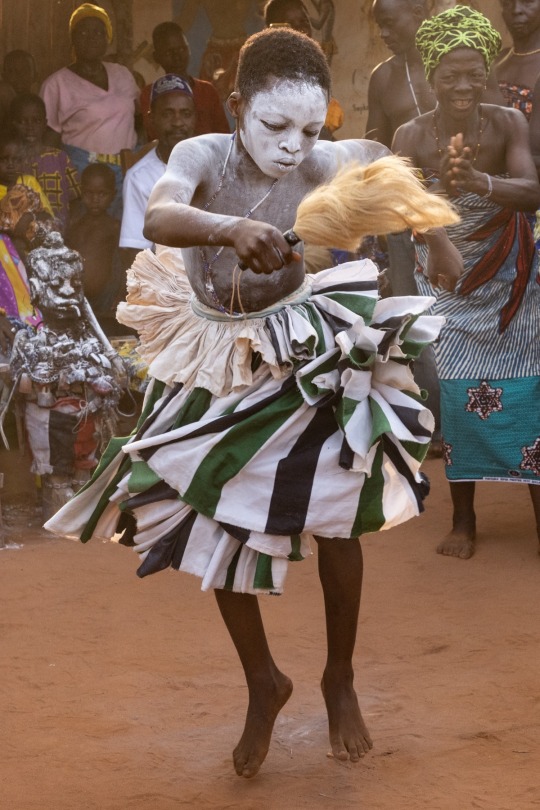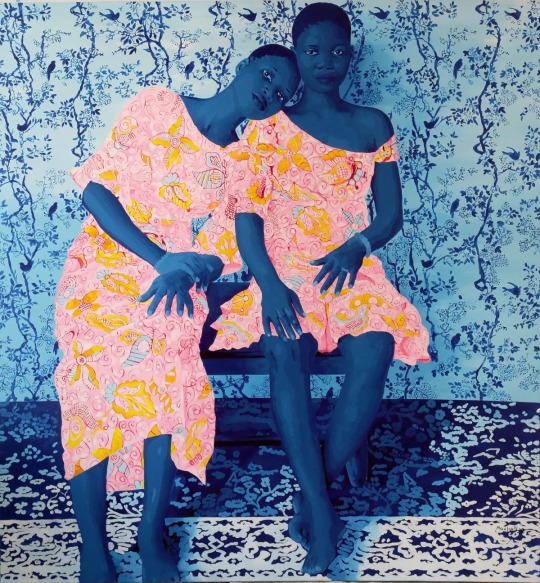#beninese
Text

Voodoo dancer, Benin, by Inger Vandyke
#voodoo#benin#beninese#africa#western africa#traditional clothing#traditional fashion#cultural clothing#folk clothing
461 notes
·
View notes
Text

Today is Independence Day in Benin, so we'd like to share a little piece of Beninese history with you!
The people is this photo are Agojie - often called Dahomey Amazons by Europeans.
The Agojie were regiments of soldiers who served in the army of Dahomey - now Benin - in West Africa in the 18th and 19th centuries. Numbering around 8000 at their height in the 1840, they were renowned for their fearlessness in battle, and considered the backbone of the Dahomean army.
The Agojie were all assigned female at birth but they expressed their gender in a variety of ways. Some renounced womanhood, and identified themselves as men. At other times, the group embraced womanhood in their war songs, comparing themselves to lionesses, and linking womanhood to their superiority over male regiments.
Learn more
[Image: photo of a group of Agojie, some pose with weapons including guns and large knives]
#benin#beninese history#queer history#agojie#african history#black history#lgbt history#lgbtq#queer#benin independence day
207 notes
·
View notes
Photo

Moufouli Bello (Beninese, 1987), Little Big Sister, 2022. Acrylic on linen, 180 x 170 cm.
585 notes
·
View notes
Text



Cyprien Tokoudagba
1 note
·
View note
Link
#Pesticides#Macroinvertebrates#Physico-chemical parameters#Alibori and Sota rivers#Beninese cotton basin
1 note
·
View note
Text
Radio Benin FM & AM + Radio Online - (Radio Android Application 🇧🇯📻)
Benin is a country in West Africa with a rich and diverse radio landscape. From national broadcasters to local community stations, there are a wide range of options for listeners across the country.
One of the most well-known radio stations in Benin is Radio Benin. Operated by the state-owned Office de Radiodiffusion et Television du Benin (ORTB), Radio Benin provides news, current affairs, music, and entertainment programs in French and several local languages.
Another major player in the Benin radio landscape is Golfe FM. Based in the economic capital of Cotonou, Golfe FM is a private radio station that plays a mix of local and international music, as well as news and current affairs programming.
In addition to these major broadcasters, Benin is also home to a number of community radio stations. These stations are often run by volunteers, and provide a platform for local voices and perspectives. They often focus on community issues and cultural programming, and are a great way to discover new artists and perspectives.
Some popular community radio stations in Benin include Radio Tokpa in Cotonou, which focuses on youth and cultural programming, and Radio Parakou in the central city of Parakou, which plays a mix of local and international music.
No matter what your interests or preferences, there is sure to be a radio station in Benin that suits your needs. With a diverse range of broadcasters and programming, Benin radio is a vibrant and dynamic part of the country's media landscape. So why not tune in today and discover what the Benin airwaves have to offer?
SO, DOWNLOAD NOW APP!! 🔽🔽
✔✔ GOOGLE PLAY STORE: ▶ https://play.google.com/store/apps/details?id=com.alexto.radio.benin
✔✔ AMAZON APP STORE: ▶ http://www.amazon.com/gp/mas/dl/android?p=com.alexto.radio.benin
✔✔ SAMSUNG GALAXY STORE: ▶ http://galaxystore.samsung.com/detail/com.alexto.radio.benin
✔✔ UPTODOWN ANDROID STORE: ▶ https://radio-benin-online-stations-fm-am-plus-app-free.en.uptodown.com/android
#radio#internet radio#radiostation#radio benin#beninese radio stations#radio benin fm#radio benin android#android#play store#amazon app store#samsung galaxy store
0 notes
Text
Quick and immediate return of affection: everything you need to know
Quick and immediate return of affection: everything you need to know
Quick and immediate return of affection
Procedures for a quick and effective return of affection
Only the Marabout, a specialist in the occult sciences of love, is able to practice a powerful return of affection . However, a novice can do this ritual himself in this case I specify that it is not a professional ritual, but a ritual for beginners. Therefore it is simplified and therefore less…

View On WordPress
#African marabout#Beninese marabout#big sighted marabout#bring back the loved one with photo#bring your ex back#competent marabout#do-it-yourself emotional return ritual#emotional return#emotional return marabout#emotional return ritual#emotional return ritual with photo#get your ex back with pic#great african marabout#great marabout#how to get husband back#how to get your ex back#how to get your ex husband back#how to get your ex wife back#how to get your loved one back#immediate emotional return#love comeback with photo#love return ritual#return love#return of affection ritual#return of loved one ritual#ritual for return of affection#ritual to recover the loved one#serious marabout#successful emotional return testimonial#the greatest african marabout
0 notes
Text

Romuald Hazoumè (Beninese, b. 1962)
Ibedji Ade, 2014
257 notes
·
View notes
Text

Didier Viodé (Beninese, b. 1979), Sans Titre, Les invisibles, 2020. Acrylic on unstretched canvas, 107 × 72 cm
570 notes
·
View notes
Text
click the source for 380 gifs of DJIMON HOUNSOU in CHARLIE’S ANGELS(2019), SERENITY(2019), WAYWARD PINES (S02/2016) . he is beninese-american with french background. please note that i do not approve of the 5+/- age rule. these were made from scratch and more may be added at my leisure, so please don’t edit, repost or claim as your own or i will eat you. tag me if you’re posting edited gif icons for public use. consider reblogging to spread poc options if useful. enjoy !



#djimon hounsou#djimon hounsou gif hunt#djimon hounsou gif pack#rph#rpc#gifsociety#userdevon#poc fc#underused fc#gif hunt#mine.#older fc
108 notes
·
View notes
Text
The French president vilified Russia as a "colonial imperial power" during a visit to Benin, which France ruled for more than 150 years.
By deciding "to invade a neighboring country to defend its interests there ... Russia is one of the last imperial colonial powers," said Emmanuel Macron on Wednesday.
He made the remarks during a press conference with his Beninese counterpart Patrice Talon in Cotonou, adding "I speak on a continent [Africa] which has undergone colonial imperialism."
France colonised the small west African country of Benin in 1894, which was at the time one of the oldest and most developed states in the region. Benin gained full independence from France in 1960. [...]
Yesterday Macron bluntly denounced what he called the "hypocrisy" -- "especially on the African continent" -- of certain governments not criticising the Russian invasion of Ukraine -- something the French leader attributed to "diplomatic pressures".
Several African countries, such as Cameroon, have not condemned Russia's behaviour, alongside many others in the Middle East and Asia.
27 Jul 22
156 notes
·
View notes
Text
Homestuck race/ethnicity nationality headcanons
Since the beta/alpha kids are like pure white in the comics my brain immediately envisioned them as white and unfortunately it’s still the first place my mind goes but I do like to think most of them aren’t totally white
The trolls are based mostly on canon references, vibes, their lands in sburb, and their dancestors
John and Jane: white | polish/dutch | american (washington)
They’re white and nerdy sorry
Rose and Roxy: white/middle eastern | french/egyptian | american (new york)
I’m all for french lalondes but I also remembered Roxy’s planet had pyramids and decided they were Egyptian too
Dave and Dirk: white/east asian | spanish/japanese | american (texas)
The striders live in Texas so they’re most likely Spanish descent but they also reference Japanese culture so often that I just had to include it
Jade and Jake: white/pacific islander | english/tongan | american (phoenix islands)
The Britishness is from Jake and the polynesian part is from jade, they’re tan af
Aradia: latina/east asian | mexican/japanese | japanese
I know that canonically she’s supposed to be Japanese so she is part japanese but the dark curly hair, desert climate, obsession with death (day of the dead) made me assume she was Latina the first time I read the comic 🤷♀️
Tavros: latino/southeast asian | mexican/filipino | mexican
Man’s obviously latino and I made him Filipino because the actor rufioh is based off is filipino
Sollux: white/east asian | french/korean | canadian (quebec)
French because I immediately decided he was Canadian so french is statistically likely but he also has some Asian vibes so I chose the one country that’s split in two, obviously
Karkat: white | romanian/jewish | american (maine)
Karkat is super pale in such a way that his eye bags are extremely noticeable. He’s Romanian as a reference to vlad the impaler and all the castle ruins in Romania which remind me of his land. He’s Jewish for vibe reasons. Maine for lobsters and and crabs 🦀
Nepeta: white | english/german | american (tennessee)
Because I picture her with blonde hair (like a lions mane). She lives near the Smokey mountains where there are a small population of mountain lions and she’s a crazy wilderness explorer. Think of how cute she’d be with a Tennessee accent
Kanaya: south asian/middle eastern | indian/iranian | american (pennsylvania)
Vibes, imagine her in a sari or any other traditional Indian clothes, she’d be stunning
Terezi: white | greek/irish | greek
The scales, democracy, hello? Also she’s absolutely a red head
Vriska: white | greek/turkish | cypriot
Vriska is definitely white and she’s a pirate so instead of Caribbean (which is mostly black) she’s Mediterranean.
Equius: black | sudanese | american (kentucky)
He’s definitely black and he has locs like you wouldn’t believe. Kentucky because of mammoth cave as a reference to his land and also because of the horse derby
Gamzee: black/white | beninese/portuguese | brazilian
Hes definitely black coded in some ways but the icp are white sooo he’s both. I made him Brazilian for carnival
Eridan: white | scottish/english | american (california)
It’s giving imperialism and Silicon Valley simultaneously
Feferi: white/black | italian/trinidadian | italian
The only reason she’s half white is because I picture her with this light red strawberry blonde hair and it’s also a reference to the Roman Empire. She’s Trinidadian because I headcanon meenah as having a voice like nicki minaj
#homestuck#homestuck headcanons#john egbert#dave strider#rose lalonde#jade harley#jake english#roxy lalonde#jane crocker#dirk strider#karkat vantas#aradia medigo#tavros nitram#sollux captor#nepeta leijon#kanaya maryam#terezi pyrope#vriska serket#equius zahhak#gamzee makara#eridan ampora#feferi peixes
37 notes
·
View notes
Text
Titus keeps reaching out, celebrating the harvest by singing in the actor’s native Beninese Fon, as heard by the robot Jimmy—watching the activities in the village from a distance. It recalls the cross-cultural communication between Hounsou’s Cinque and Hopkins’ John Quincy Adams in the Spielberg film. Jimmy listens to Titus’ song while ruminating on the galactic sky above, the perspective of which Snyder orients through Jimmy’s crown of antlers—searching for meaning in the wake of the slain king of the universe.
2 notes
·
View notes
Text
340: Various Artists // Two Tribes

Two Tribes
Various Artists
2019, Agogo (Bandcamp)
A double-LP mixtape/compilation from Hannover electronic label Agogo Records, Two Tribes “makes an effort to give insight in how [sic] musicians living in Europe today incorporate and transfer musical traditions particularly from the African continent into their oeuvre” (per the liner notes). Ostensibly, everyone here is either a musician living in Europe with African roots of some kind, or is a European musician collaborating with Africans, though in some cases what you get is just a Euro DJ using a few “tribal” sounding drum stems.
youtube
I had a lot of fun listening to the most ‘70s sounding funk stuff here and trying to guess how white the musicians were, but I was underprepared for the intensity of unpasteurized Funky Continental Guyness I was exposed to. Winners included guitarist Petri Kautto of Finnish-Beninese Afro-jazz combo Trio Toffa (pretty good), who strongly resembles Bill Nighy wearing a bucket hat with fake dreads attached to it, and Berlin’s slavishly authentic Afro-funk group Onom Agemo and the Disco Jumpers, who look like the S-Bahn Bloodhound Gang.

Petri Kauto of Trio Toffa

Onom Agemo and the Disco Jumpers
The compilation has what strikes me as a downright quaint (and very German) attitude towards the notion of cultural exchange that runs the risk of being pilloried for appropriation, but I’m sympathetic to it. Certainly, a collaboration like that between Zimbabwean mbira player Jacob Mafuleni and French DJ Gary Gritness that is neither explicitly “African” or “European” is by nature a more truly cross-cultural enterprise than Onom Agemo’s reverent homage or German DJ Elias “Agogo” Foerster’s vaguely Books-ish chops of African beat and vocal samples, but whatever. Influence is impossible to strictly regulate, and I don’t know that it’s even desirable to. White guys nerding out and riffing on the music of the cultures their governments currently oppress isn’t a problem—that their governments are oppressing those cultures, and that the scenes they operate within often have the taint of trickled down racism despite their utopian values, is. One hopes that Agogo and these musicians are cognizant of these challenges, even as they radiate a genuine and laudable affection for African music.
It’s worth noting that, while the European club sounds represented range from ‘90s style techno and 2-step to more modern forms of minimal house and bass music, the African face of the coin is almost exclusively defined by the funky ‘70s and ‘80s sounds that drive record collectors into quasi-sexual spasms. Being one of those guys, I don’t mind it aesthetically, but it’s interesting that the most contemporary-sounding piece is the 15-minute minimal house track “Just in a Moment to Find a Way to Sun Day” by Ivorian-born Hamburg DJ Raoul K. The centrepiece of K’s track sounds to me like a synthesized mbira, but he doesn’t feel the need to flag his music as African—perhaps because he actually is a young guy of African descent. Instead, he puts on a master class in using simple shifts in rhythm and dynamics to keep a room vibing in near perpetuity.
youtube
Anyway, as a mix, Two Tribes contains a lot of fine music and flows nicely. I dig Andrea Benini’s Francis Bebey-esque “Jawa” and the K track in particular, but nothing aside from Selma Uamusse’s anime-sounding “Mozambique (Ao Sul Do Mundo)” actively irks me. I’ve listened to Two Tribes a lot more than many other records in my collection that dig deeper, or make more powerful statements, because in the end, I just like the way it sounds.
340/365
#agogo#afrobeat#house music#electronic music#afro jazz#fusion#andrea benini#gary gritness#raoul k#trio toffa#jacob mafuleni#blay ambolley#the sorcerers#healing force project#selma uamasse#david hanke#cultural exchange#cultural appropriation#music review#vinyl record#african music#german music
2 notes
·
View notes
Text
This day in history

I'm on tour with my new, nationally bestselling novel The Bezzle! Catch me WEDNESDAY (Mar 13) in SAN FRANCISCO with ROBIN SLOAN, then Anaheim, and more!

#20yrsago Everquest widows tell all https://eqdailygrind.blogspot.com
#15yrsago Warner Music attacks babies https://www.eff.org/deeplinks/2009/03/fair-use-massacre-continues-now-warner-s-going-aft
#15yrsago Net Neutrality gave us the Web and saved us from gopher https://www.vice.com/en/article/xywdqk/what-the-first-website-ever-says-about-the-world-wide-webs-that-might-have-been
#15yrsago China’s mondegreen war on net-censorship http://radar.oreilly.com/2009/03/etech-liveblogging-lessons-fro.html
#15yrsago Influences on the Laugh-Out-Loud Cats https://www.neatorama.com/2009/03/10/the-influences-behind-the-laugh-out-loud-cats-by-adam-koford/
#15yrsago IT versus users: a war that everyone loses https://web.archive.org/web/20090312222459/http://blogs.harvardbusiness.org/now-new-next/2009/03/the-high-priests-of-it.html
#15yrsago Billy Bragg and a coalition of UK rock stars speak up for downloaders https://www.independent.co.uk/arts-entertainment/music/news/it-s-not-a-crime-to-download-say-musicians-1643217.html
#10yrsago Free to Be…You and Me is 40 https://www.cnn.com/2014/03/11/living/free-to-be-you-and-me-40-years/index.html
#10yrsago Security as a public health discipline, not an engineering one https://www.theguardian.com/technology/2014/mar/11/gchq-national-security-technology
#10yrsago How the NSA plans to automatically infect “millions” of computers with spyware https://theintercept.com/2014/03/12/nsa-plans-infect-millions-computers-malware/
#10yrsago Thoughts on teaching calculus to five-year-olds https://www.theatlantic.com/education/archive/2014/03/5-year-olds-can-learn-calculus/284124/
#10yrsago Tim Berners-Lee calls for Web “Magna Carta” – does the “Web we want” have DRM in it? https://memex.craphound.com/2014/03/12/tim-berners-lee-calls-for-web-magna-carta-does-the-web-we-want-have-drm-in-it/
#5yrsago Trump’s FCC relies on telcos to self-police anti-robocall measures and they’re planning on gutting existing regs, so John Oliver is robocalling the whole FCC every 90 minutes https://arstechnica.com/tech-policy/2019/03/john-oliver-fights-robocalls-by-robocalling-ajit-pai-and-the-fcc/
#5yrsago Beninese musician/activist/genius Angélique Kidjo has released a tribute to Talking Heads’ Remain in Light and IT. IS. FUCKING. AMAZING. https://www.kidjo.com/remain-in-light
#5yrsago Offshore illegal GOP campaign megadonors receive record FEC fines after The Intercept reveals their crimes https://theintercept.com/2019/03/11/intercept-investigation-leads-to-record-fines-over-foreign-campaign-contributions/
#5yrsago What ephemeral messaging is good for https://memex.craphound.com/2019/03/12/what-ephemeral-messaging-is-good-for/
#5yrsago One company bought all the retail outlets for glasses, used that to force sales of all the eyewear companies and jacked up prices by as much as 1000% https://www.latimes.com/business/lazarus/la-fi-lazarus-glasses-lenscrafters-luxottica-monopoly-20190305-story.html
#1yrsago Spirit warned investors that merging with Jetblue would be illegal https://pluralistic.net/2023/03/12/they-put-it-in-writing/#that-was-then

Name your price for 18 of my DRM-free ebooks and support the Electronic Frontier Foundation with the Humble Cory Doctorow Bundle.
5 notes
·
View notes
Text

At its height in the 1840s, the West African kingdom of Dahomey boasted an army so fierce that its enemies spoke of its “prodigious bravery.” This strong force, known as the Agojie, raided villages under cover of darkness, took captives and slashed off resisters’ heads to return to their king as trophies of war. Through these actions, the Agojie established Dahomey’s preeminence over neighboring kingdoms and became known by European visitors as “Amazons” due to their similarities to the warrior women of Greek myth. They were also called Mino, or Minon, "our mothers".
During their membership, they were not allowed to have children or be part of married life (though they were legally married to the king). Many of them were virgins.
The Mino trained with intense physical exercise. They learned survival skills and indifference to pain and death, storming acacia-thorn defenses in military exercises and executing prisoners. Discipline was emphasized. Serving in the Mino offered women the opportunity to "rise to positions of command and influence" in an environment structured for individual empowerment. The Mino were also wealthy and held high status.
The women's army consisted of many regiments: huntresses, riflewomen, reapers, archers, and gunners. Each regiment had different uniforms, weapons, and commanders. In a later period, the Dahomean female warriors were armed with Winchester rifles, clubs, and knives. Units were under female command.
In 1890 King Béhanzin started fighting French forces during the First Franco-Dahomean War. European observers noted that the women "handled admirably" in hand-to-hand combat. The Amazons participated in one major battle: Cotonou, where thousands of Dahomey (including many Amazons) charged the French lines and engaged the defenders in hand-to-hand combat. Despite the compliments given to them by the Europeans, the Amazons were decisively crushed, with several hundred Dahomey troops being gunned down.
By the end of the Second Franco-Dahomean War, special units of the Amazons were being assigned specifically to target French officers. After several battles, the French prevailed and ended the independent Dahomean kingdom. French soldiers, particularly of the French Foreign Legion, were impressed by the boldness of the Amazons and later wrote about their "incredible courage and audacity" in combat.
The troops were disbanded when the kingdom became a French protectorate. Oral tradition states that some surviving amazons secretly remained in Abomey afterward, where they quietly assassinated some French officers. Other stories say the women pledged their services to protect Agoli-Agbo, the brother of Béhanzin, disguising themselves as his wives to guard him. Some of the women married and had children, while others remained single.
The last survivor of the Dahomey Amazons is thought to have been a woman named Nawi. In a 1978 interview in the village of Kinta, a Beninese historian met Nawi, who claimed to have fought the French in 1892. Nawi died in November 1979, aged well over 100.
•••
Estando en su mejor momento en los 1840, el reino Dahomey ubicado en África occidental, presumía de un ejército tan feroz que hasta sus enemigos hablaban acerca de su “prodigiosa valentía”. Estas fuerzas poderosas eran conocidas como las Agojie, atacaban pueblos mientras que iban cubiertas por la oscuridad de la noche, tomaban cautivos y cortaban cabezas para llevárselas como trofeo de guerra a su rey. A través de estas acciones, las Agojie establecieron preeminencia sobre los reinos vecinos y fueron conocidas por los visitantes europeos como "Las Amazonas" debido a sus similitudes con las mujeres guerreras del mito griego. También fueron llamadas Mino, o Minon, "nuestras madres".
Mientras que fueran miembros de las fuerzas, no se les permitía tener hijos o ser parte de la vida matrimonial (aunque estaban legalmente casadas con el rey). Muchos de ellas eran vírgenes.
Las Mino se entraban con ejercicios físicos intensos. Aprendieron habilidades de supervivencia e indiferencia al dolor y la muerte, asaltaban defensas en ejercicios militares y ejecutaban prisioneros. Se enfocaron en la disciplina. Servir como Minons, le ofreció a las mujeres la oportunidad de "ascender a puestos de mando e influencia" en un entorno estructurado para el empoderamiento individual. Las Mino también eran ricas y tenían un alto estatus.
Este ejército de mujeres consistían de varios regimientos: cazadoras, fusileras, segadoras, arqueras y artilleras. Cada regimiento tenía diferentes uniformes, armas y comandantes. En un período posterior, las guerreras de Dahomey estuvieron armadas con rifles Winchester, garrotes y cuchillos. Las unidades estaban bajo mando femenino.
En el año 1890, el rey Béhanzin comenzó a luchar contra las fuerzas francesas durante la Primera Guerra Franco-Dahomeana. Los observadores europeos notaron que las mujeres "se manejaron admirablemente" en el combate mano a mano. Las amazonas participaron en una gran batalla: Cotonou, donde miles de Dahomey (incluidas muchas de las amazonas) atacaron las líneas francesas y se enfrentaron a los defensores en un combate mano a mano. A pesar de los cumplidos que les dieron los europeos, las amazonas fueron aplastadas de manera decisiva, y cientos de soldados Dahomey fueron asesinados a tiros.
Al final de la Segunda Guerra Franco-Dahomeana, se asignaron unidades especiales de las Amazonas específicamente para atacar a los oficiales franceses. Después de varias batallas, los franceses prevalecieron y terminaron con el reino independiente de Dahomey. Los soldados franceses, específicamente los de la Legión Extranjera Francesa, quedaron impresionados por la audacia de las amazonas y luego escribieron acerca del "increíble coraje y audacia" que mostraron en combate.
Las tropas se disolvieron cuando el reino se convirtió en un protectorado francés. La tradición oral dice que algunas amazonas sobrevivientes permanecieron en secreto en Abomey, donde asesinaron en silencio a algunos oficiales franceses. Otras historias dicen que las mujeres prometieron servir y proteger a Agoli-Agbo, el hermano de Béhanzin, muchas disfrazándose como esposas para protegerlo. Algunas de las mujeres se casaron y tuvieron hijos, mientras que otras permanecieron solteras.
Se cree que la última sobreviviente de las amazonas de Dahomey fue una mujer llamada Nawi. En una entrevista de 1978 en el pueblo de Kinta, un historiador beninés conoció a Nawi, quien afirmó haber luchado contra los franceses en 1892. Nawi murió en noviembre de 1979, con más de 100 años.
Source | Fuente: African American Registry
Spanish translation by Long Live Blackness
Traducción al español por Long Live Blackness
#blacklivesmatter#blacklivesalwaysmatter#english#spanish#blackhistory#history#share#read#blackpeoplematter#blackhistorymonth#blackgirlsrock#black queen#blackhistoryyear#blackwomenmatter#black warriors#warriors#black lives matter#blm#newpost#historyfacts#african history#blackbloggers#lupita nyong'o#knowyourhistory#knowledgeisfree#knowledgeispower#did you know#dahomey#2022#kingdom
26 notes
·
View notes